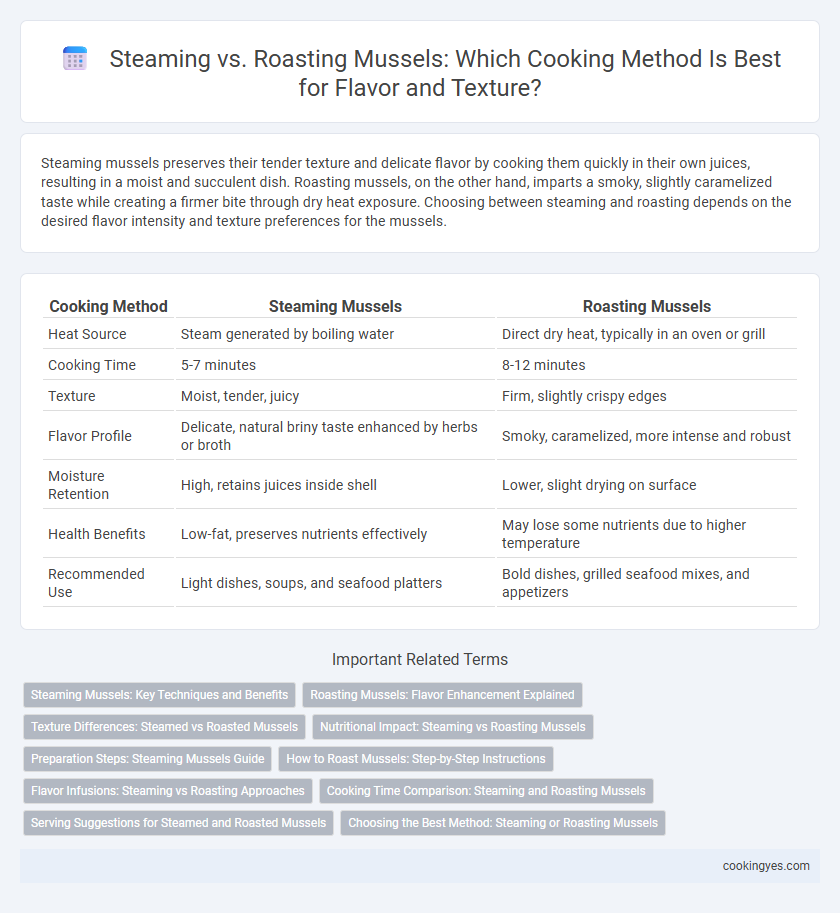Steaming mussels preserves their tender texture and delicate flavor by cooking them quickly in their own juices, resulting in a moist and succulent dish. Roasting mussels, on the other hand, imparts a smoky, slightly caramelized taste while creating a firmer bite through dry heat exposure. Choosing between steaming and roasting depends on the desired flavor intensity and texture preferences for the mussels.
Table of Comparison
| Cooking Method | Steaming Mussels | Roasting Mussels |
|---|---|---|
| Heat Source | Steam generated by boiling water | Direct dry heat, typically in an oven or grill |
| Cooking Time | 5-7 minutes | 8-12 minutes |
| Texture | Moist, tender, juicy | Firm, slightly crispy edges |
| Flavor Profile | Delicate, natural briny taste enhanced by herbs or broth | Smoky, caramelized, more intense and robust |
| Moisture Retention | High, retains juices inside shell | Lower, slight drying on surface |
| Health Benefits | Low-fat, preserves nutrients effectively | May lose some nutrients due to higher temperature |
| Recommended Use | Light dishes, soups, and seafood platters | Bold dishes, grilled seafood mixes, and appetizers |
Steaming Mussels: Key Techniques and Benefits
Steaming mussels preserves their natural flavor and tender texture while ensuring even cooking by using moist heat at a controlled temperature. This method typically requires only a few minutes, preventing overcooking and maintaining optimal juiciness. Steamed mussels retain more nutrients compared to dry-heat methods, making steaming a healthy and flavorful cooking approach.
Roasting Mussels: Flavor Enhancement Explained
Roasting mussels intensifies their natural brininess by caramelizing their exterior, which creates a rich, smoky flavor profile not achieved through steaming. The dry heat of roasting also crisps the shell edges and enhances the texture of the meat, providing a unique culinary experience. This method allows for the infusion of herbs and spices directly onto the mussels, amplifying their aromatic qualities and overall taste complexity.
Texture Differences: Steamed vs Roasted Mussels
Steamed mussels retain a tender, juicy texture due to the gentle cooking process that preserves their natural moisture. Roasted mussels develop a firmer, slightly chewy texture with a caramelized exterior from direct dry heat exposure. The choice between steaming and roasting significantly alters the mussels' mouthfeel and flavor intensity.
Nutritional Impact: Steaming vs Roasting Mussels
Steaming mussels preserves more water-soluble vitamins like B12 and minerals such as zinc due to the gentle cooking process that minimizes nutrient loss. Roasting mussels can enhance flavor through caramelization but may lead to slight reductions in heat-sensitive nutrients and increased fat content if oils are used. Overall, steaming offers a nutritionally superior method by maintaining mussels' essential vitamins and minerals without added fats.
Preparation Steps: Steaming Mussels Guide
Steaming mussels begins by thoroughly rinsing and debearding each shell to remove grit and impurities. Place the cleaned mussels in a pot with a small amount of liquid such as water, white wine, or broth, ensuring enough steam is generated but mussels remain partially submerged. Cover the pot tightly and cook over medium-high heat for 5-7 minutes until the shells open, indicating the mussels are fully cooked and ready to serve.
How to Roast Mussels: Step-by-Step Instructions
To roast mussels, preheat the oven to 450degF (230degC) and spread cleaned mussels evenly on a baking sheet lined with foil. Drizzle with olive oil, minced garlic, and your choice of herbs such as parsley or thyme, then roast for 8-10 minutes until the shells open and the mussels are cooked through. Remove any unopened shells and serve immediately with a squeeze of lemon for enhanced flavor.
Flavor Infusions: Steaming vs Roasting Approaches
Steaming mussels preserves their natural briny flavor while allowing subtle infusions from herbs, garlic, and white wine to penetrate the shells, creating a delicate and aromatic profile. Roasting mussels intensifies their taste with caramelized notes and a smoky depth, often enhanced by butter, garlic, and chili flakes that crisp the edges and add texture contrast. Choosing between steaming and roasting hinges on whether a light, fragrant essence or a robust, savory complexity is desired for the final dish.
Cooking Time Comparison: Steaming and Roasting Mussels
Steaming mussels typically takes about 5 to 7 minutes, allowing the shells to open while retaining moisture and a tender texture. Roasting mussels requires a longer cooking time, around 10 to 15 minutes, which results in a more intense, smoky flavor and slightly firmer flesh. Choosing between steaming and roasting depends on desired taste and texture, with steaming offering quicker preparation and roasting providing enhanced depth of flavor.
Serving Suggestions for Steamed and Roasted Mussels
Steamed mussels are best served with a light broth made from white wine, garlic, and fresh herbs, which enhances their natural briny flavor and keeps the texture tender. Roasted mussels benefit from bold, savory toppings like garlic butter, breadcrumbs, and grated Parmesan, creating a rich, crispy finish that contrasts with the tender shellfish. Pair steamed mussels with crusty baguette for dipping in the aromatic broth, while roasted mussels are perfect as a standalone appetizer or paired with a side salad to balance the richness.
Choosing the Best Method: Steaming or Roasting Mussels
Steaming mussels preserves their natural briny flavor and tender texture by cooking them gently with steam, making it ideal for maintaining juiciness and freshness. Roasting mussels, on the other hand, imparts a smoky, caramelized flavor and slightly firmer texture, perfect for adding depth and complexity to dishes. Choosing the best method depends on whether you prioritize the delicate freshness of steamed mussels or the robust, charred notes achieved through roasting.
Steaming vs roasting for mussel cooking method Infographic

 cookingyes.com
cookingyes.com